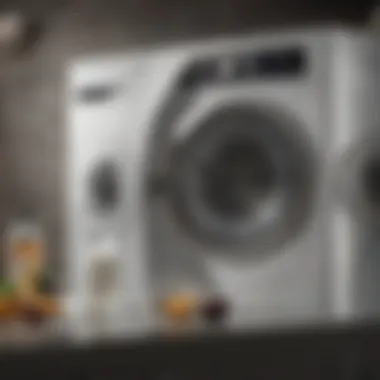Sanitize Your Clothes Washer: A Complete Guide


Intro
Maintaining hygiene in your laundry routine is crucial. Most people overlook the clothes washer, but this appliance can harbor bacteria, mold, and mildew if not sanitized properly. This guide will discuss methods to ensure your washer remains clean and efficient. Understanding how to sanitize your clothes washer not only protects your health but also improves the longevity of the appliance.
In this article, we will highlight essential techniques for sanitizing both front-load and top-load washers. We will also cover common issues such as mold growth and the importance of regular maintenance. Moreover, you will find practical tips and the right materials needed to keep your washing machine in optimal condition, regardless of its type.
Importance of Sanitizing your Washer
Sanitizing your clothes washer is important for several reasons:
- Preventing Mold and Mildew: Clothes washers can retain moisture. Without proper cleaning, mold and mildew can thrive.
- Odor Control: A sanitized washer helps avoid unpleasant smells that can transfer to your laundry.
- Prolonging Appliance Life: Regular maintenance can keep your washer operating effectively and reduce the risk of breakdowns.
By following the techniques outlined here, you can achieve a cleaner, more efficient washer, enhancing your laundry experience.
Understanding the Importance of Sanitation
Sanitation of your clothes washer is a crucial practice that often goes overlooked. A washer with poor sanitation can harbor bacteria, mold, and other contaminants which can affect both your health and the cleanliness of your laundry. More than just removing visible dirt, proper sanitation ensures a hygienic environment that contributes to the overall longevity of your appliance. Regular cleaning aids in the efficient operation of your washer, which can reduce energy costs and improve washing performance.
In our everyday lives, we are surrounded by pathogens and dirt. It is essential to minimize the risk of these contaminants transferring to our fabrics. Additionally, understanding how to maintain a clean washer reflects our regard for personal health and hygiene. Now, let’s delve deeper into the specific benefits of having a clean washer.
Health Benefits of a Clean Washer
A clean washer plays an important role in promoting health. During the washing process, contaminants can build up on components such as the drum, hoses, and dispensers. This build-up can lead to the proliferation of bacteria and mold, which may inadvertently transfer onto your clothes. Here are some key health benefits associated with a sanitized washer:
- Reduced Allergens: Keeping your washer clean reduces allergens, such as dust mites and mold spores, which can trigger allergies and respiratory issues.
- Elimination of Odors: Regular sanitation prevents the build-up of unpleasant odors caused by bacteria or mildew. This ensures that your clothes smell fresh after each wash.
- Enhanced Skin Health: Contaminants in your washer can lead to skin irritations or allergies, particularly for individuals with sensitive skin.
By maintaining a clean washer, you ensure that hygiene standards are upheld, allowing your family to wear clothes that are not just visually clean but also hygienic.
Common Contaminants Found in Washers
Several types of contaminants are known to inhabit clothes washers, often unnoticed by users. Understanding these contaminants helps in comprehending the levels of risks involved in washing clothes in a neglected machine. Some of the most common found include:
- Mold and Mildew: Damp environments such as washers can easily foster mold growth. Mold can thrive on residues and moisture left in the washer post-wash.
- Bacteria: Laundry that isn't properly cleaned can harbor harmful bacteria, potentially leading to health issues such as stomach illnesses.
- Soap Scum: Build-up from detergents can accumulate over time, forming a sticky residue that can harbor further bacteria.
Being aware of these contaminants emphasizes the need for regular sanitization of your washing machine. This practice not only fortifies health but also helps in maintaining the integrity of your laundry.
Identifying the Right Time to Sanitize
In maintaining a clothes washer, knowing when to sanitize is essential for ensuring prolonged functionality and hygiene. A washer that is not cleaned regularly can become a breeding ground for bacteria, mildew, and unpleasant odors. Understanding the indicators that signal a need for sanitization can greatly improve appliance performance and laundry quality. Moreover, it reduces the risk of transferring contaminants to clean clothes, thereby fostering a healthier home environment.
Signs That Your Washer Needs Cleaning
It is vital to be aware of specific signs that indicate your washer needs cleaning. These signs often suggest the presence of residue or buildup that can impair washing efficiency. Here are the key indicators:
- Unpleasant Odors: A notable musty or sour smell is usually the first warning sign. This odor often comes from stagnant water or mold accumulating inside the washer.
- Visible Mold or Mildew: Appearance of black or green patches around the seals, drum, or dispenser is a clear sign that sanitization is necessary. Mold can thrive in damp, dark environments commonly found in washers.
- Residue Build-Up: If you notice soap scum or residue left on laundry after washing, this indicates that the washer needs a thorough clean.
- Discolored Laundry: If whites start turning grey or getting dingy, it might reflect an unclean drum that is not rinsing itself adequately.
- Water Stagnation: Water pooling at the bottom of the washer or in the detergent drawer can lead to bacteria growth, necessitating immediate cleaning.
Regularly assessing for these signs can promote a proactive approach to washer maintenance, saving energy and enhancing hygiene.
Frequency of Cleaning


Deciding how often to clean your washer is equally important. Various factors may influence the frequency, including usage patterns and detergent types. Here are some considerations:
- Usage Frequency: If you do multiple loads daily, consider sanitizing your washer once a month. The more often you use it, the quicker residue builds up.
- Type of Detergent: Powder detergents may leave more residue than liquid types, potentially requiring more frequent cleaning.
- Local Water Quality: Hard water areas often lead to limescale buildup, necessitating a more regular cleaning routine.
- General Guidelines: A good rule of thumb is to perform a deep clean of your washer every one to three months. Adjust based on personal usage and observed cleanliness.
By recognizing signs that indicate a need for cleaning and establishing a reasonable frequency for sanitization, you enable your clothes washer to operate optimally. Not only will this extend the lifespan of the appliance, but it will also improve the cleanliness and odor of your laundry.
Materials Needed for Sanitization
Understanding the materials needed for sanitizing your clothes washer is essential. Proper sanitation not only ensures a cleaner environment for your laundry but also extends the life of your machine. Without the right supplies, it can be challenging to address common issues that arise from a lack of cleanliness in washers. This section will guide you through what you need to achieve effective sanitation.
Essential Cleaning Supplies
When it comes to sanitizing your washer, certain cleaning supplies are more effective than others. These tools will help ensure that every part of your machine is clean, contributing to better washing performance.
- Vinegar: A natural disinfectant, vinegar can effectively kill bacteria and dissolve mineral deposits. It is safe for both front-load and top-load machines.
- Baking Soda: This versatile substance not only deodorizes but also sanitizes. It can help combat stubborn stains and residues.
- Bleach: Ideal for heavily soiled washers, bleach helps eliminate mold and mildew. However, it should be used with caution, as it can damage some components.
- Microfiber Cloths: Soft and absorbent, microfiber cloths are perfect for wiping down surfaces without scratching. They are effective for cleaning all parts of the washer, including the drum and rubber seals.
- Scrub Brush: A gentle scrub brush can help dislodge built-up grime or soap residue, especially in hard-to-reach areas.
These supplies are easily accessible and often already found in most households. Using them consistently will improve the hygiene of your clothes washer.
Homemade Cleaning Solutions
If you prefer a more natural approach, creating homemade cleaning solutions can be an effective alternative. These mixtures often utilize common household ingredients and can be just as potent as store-bought cleaners.
- Vinegar and Baking Soda: Combining these two creates a potent cleaning solution. Start by pouring two cups of vinegar into the drum. Follow with half a cup of baking soda. Run a hot water cycle without any clothes.
- Essential Oils: Adding a few drops of tea tree or lavender oil to your cleaning solution can enhance antibacterial properties, imparting a pleasant scent as well.
- Lemon Juice: The acidity of lemon juice helps remove stains and odors. Mixing lemon juice with water in a spray bottle can provide an effective surface cleaner.
Using these home solutions not only reduces reliance on commercial products but can also be more environmentally friendly. Additionally, they are generally less expensive and can be made in small batches as needed.
Step-by-Step Guide for Sanitizing Different Types of Washers
Sanitizing your clothes washer is a critical component of maintaining cleanliness in your home. This section will provide a clear and concise approach for both front-load and top-load washers. Understanding the specific needs of each type helps ensure that your equipment operates efficiently and effectively. By following these step-by-step guides, you can extend the lifespan of your washer while also safeguarding your laundry against bacteria and unpleasant odors.
Sanitizing Front-Load Washers
Front-load washers are popular for their efficiency and cleaning performance. However, their design can sometimes trap moisture, making them particularly susceptible to mold and mildew. Here is a thorough guide to sanitize your front-load washer:
- Empty and Inspect: First, ensure the drum is empty. Check for any foreign items that may remain from previous loads.
- Add Sanitizing Solution: Use a mixture of vinegar and baking soda. Pour two cups of white vinegar into the detergent dispenser and sprinkle a half cup of baking soda directly into the drum.
- Run a Cleaning Cycle: Set your washer to the hottest wash cycle. If your machine has a specific cleaning cycle, choose that option. This helps dissolve and flush out any residues or odors.
- Wipe Down Components: After the cycle ends, take a clean cloth and wipe the door seal, drum, and inner door glass. Check the gasket for any hidden debris or mold buildup.
- Leave the Door Open: Allow the door to remain open for a few hours. This action promotes airflow, reducing moisture and preventing future mold growth.
Following this method regularly not only sanitizes your washer but also improves its efficiency and overall performance.
Sanitizing Top-Load Washers
Top-load washers, while generally less prone to mold, also require regular cleaning to maintain hygiene. Below are the essential steps:
- Empty the Washer: Just like with front-load washers, start by ensuring that the drum is empty.
- Prepare the Cleaning Solution: Fill the washer with hot water and add one quart of bleach. Allow it to agitate for a few minutes to mix the bleach thoroughly with the water.
- Soak and Agitate: Stop the cycle and let the solution sit for approximately one hour. This soaking period assists in breaking down any grime or residues.
- Complete the Cycle: After soaking, restart the machine to complete the wash cycle. This will help remove any lingering contaminants.
- Clear Out the Fabric Softener Dispenser: If your model has a fabric softener dispenser, clean it thoroughly. Remove it if possible, and wash it with hot, soapy water to remove any build-up.
- Wipe and Air Dry: Once the cycle is complete, use a damp cloth to wipe down the inner sides, lid, and any other areas where dirt may accumulate. Leave the lid open for a few hours afterward.
Practicing these sanitization methods for your top-load washer ensures a clean and healthy laundry environment. Regularly maintaining both types of washers can lead to more efficient washing and reduce the risks associated with mold and odors.
Cleaning Specific Components
Keeping your clothes washer sanitary goes beyond just a general cleaning. Specific components require dedicated attention to ensure optimal performance and hygiene. Neglecting these parts can lead to contaminants accumulating over time, which can affect both the cleanliness of your laundry and the lifespan of your appliance.
Cleaning the Drum


The drum is the heart of the washer, where all the cleaning action happens. It is crucial to address any residue or build-up here. Over time, detergent residues, fabric softeners, and even lint can accumulate, creating a breeding ground for bacteria and unpleasant odors.
How to Clean the Drum:
- Use a mixture of vinegar and baking soda. This not only eliminates odors but also helps to break down any residues.
- Run a cycle with hot water. This is especially effective after you have applied your cleaning mixture.
Cleaning the drum regularly ensures that each wash cycle is as effective as possible. This extra step can greatly improve the freshness of your clothes.
Cleaning Detergent Dispensers
Detergent dispensers are often overlooked yet play an essential role in the washing process. Residue from liquid detergents or softeners can clog these compartments. This build-up can prevent proper dispensing, leading to ineffective cleaning.
Steps to Clean Detergent Dispensers:
- Remove the dispenser tray and soak it in hot soapy water.
- Use a soft brush to scrub away any build-up, paying special attention to corners.
- Rinse and dry thoroughly before reinserting.
Regular cleaning of your detergent dispensers aids in maintaining the efficiency of your washer. It can also prevent any unpleasant odors from forming.
Maintaining Door Seals and Gaskets
The door seals and gaskets are crucial for preventing leaks and ensuring the washer runs efficiently. However, moisture often gets trapped here, creating a perfect environment for mold and mildew.
To Maintain Door Seals and Gaskets:
- After each load, wipe down the gasket with a dry cloth to remove moisture.
- Periodically inspect for any signs of mold. If you notice any, clean with a mixture of water and vinegar.
- Ensure the door is left open to allow it to dry completely after use.
Taking care of the seals and gaskets helps to maintain the integrity of the washer and allows for a more hygienic washing environment. This quick maintenance step can prevent costly repairs in the future.
"A sanitized washer not only cleans clothes better but also prolongs the life of the appliance."
In summary, focusing on these specific components is vital for achieving a truly clean washer. Regular and thorough cleaning of the drum, detergent dispensers, and door seals will enhance overall performance and hygiene.
Prevention Strategies to Maintain Hygiene
Sanitizing your clothes washer is not merely a one-time task. Engaging in prevention strategies to maintain hygiene is crucial for ensuring a consistently clean washing environment. Regular maintenance can substantially reduce the buildup of contaminants, leading to healthier laundry and prolonging the life of the machine. The importance lies in proactive measures that address potential problems before they escalate. This section highlights general practices and long-term strategies that help keep your washer clean and functioning optimally.
Best Practices After Each Wash
To achieve consistent cleanliness in your washer, implement best practices after each laundry load. These small habits can make a significant difference over time:
- Leave the door ajar: After finishing a wash cycle, always leave the washer door slightly open. This helps evaporate moisture inside, preventing mold and mildew.
- Wipe down surfaces: Use a clean cloth or sponge to wipe the drum, door seal, and detergent dispenser. Any residual moisture or detergent can foster bacteria growth.
- Check for items left behind: After each wash, inspect the drum and remove any small items like lint or fabric that may remain. This reduces the chance of clogging and unpleasant odors.
- Run a rinse cycle: Occasionally run the empty washer on the rinse cycle after particularly soiled loads. This helps flush away any leftover detergent or dirt.
By adopting these simple habits, you create a cleaner environment for every load of laundry.
Long-term Maintenance Tips
Beyond day-to-day practices, it is essential to employ long-term maintenance tips to preserve the hygiene of your washer:
- Regular deep cleaning: Schedule a deep clean for your washer at least once a month. Use vinegar or baking soda to eliminate odors and residues that accumulate over time.
- Inspect and replace seals: Make it a habit to periodically check the door seals for wear and tear. Damaged seals not only result in leaks but can also trap moisture, leading to mold formation.
- Use the right detergent: Always choose a high-efficiency detergent, especially in high-efficiency washers. Using the correct detergent not only cleans better but also allows for less buildup.
- Avoid overloading: Be mindful not to overload your washer. Excessive weight may lead to improper cleaning and can damage various components.
- Check water quality: If you live in an area with hard water, consider using a water softener. Hard water can lead to mineral buildup, affecting cleaning efficiency.
By adhering to these long-term maintenance practices, you ensure your machine remains in optimal condition, reducing the frequency of sanitization efforts while enhancing the durability and performance of your washer.


Troubleshooting Common Problems
In the realm of household maintenance, troubleshooting common problems in your clothes washer holds significant importance. Understanding the issues that arise in the washing machine can help maintain its effectiveness and longevity. With the right knowledge, you can address concerns such as mold, mildew, and unpleasant odors before they escalate into larger issues.
Identifying and resolving these problems not only enhances the performance of your appliance but also ensures that your clothing is cleaned in a hygienic environment. Most importantly, regular troubleshooting can save you from costly repairs down the line.
Dealing with Mold and Mildew
Mold and mildew growth are common issues that can arise in both front-load and top-load washers. These fungi thrive in moist, warm environments—exactly what a washing machine often is. When mold finds a home in your washer, it can compromise the cleanliness of your laundry and lead to health issues.
Regular inspection is crucial. Look for visible mold in door seals, dispensers, and inside the drum. If you find any, here are steps to take:
- Wash with bleach: Use a mixture of one cup of bleach to one gallon of water. With the washer empty, run a hot cycle. This will help kill mold and mildew.
- Vinegar solution: For a natural approach, add two cups of white vinegar with a hot cycle. Vinegar is effective at eliminating earthy odors and helps kill fungal spores.
- Keep the door open: Always leave the washer door ajar when not in use to promote air circulation. This reduces moisture buildup, preventing mold growth.
Implementing these methods regularly can greatly reduce the likelihood of mold and mildew settling in your machine.
Addressing Unpleasant Odors
Unpleasant odors coming from a washer can be distressing. They may originate from the water, detergent buildup, or even organic debris that becomes trapped. Addressing this issue is essential for maintaining a fresh laundry routine.
To combat these odors effectively, consider the following:
- Regular cleaning: Like the mold and mildew prevention, clean your washer with bleach or vinegar on a monthly basis.
- Identify the source: Check the drain filter for lint, hair, and other debris. Cleaning this area can eliminate odors that arise from rotting materials.
- Use less detergent: Overusing detergent can lead to buildup inside the washer, which may emit a foul smell. Ensure you’re using the appropriate amount for each load.
- Check water quality: Sometimes odors can stem from the water supply. If your water smells bad, consider using a water filter or contact your local water authority.
Taking these steps can ensure that your washer excels in both performance and the freshness of your laundry, contributing to a more pleasant washing experience.
Understanding Machine Settings and Effects on Cleaning
The machine settings play a crucial role in the sanitization process of your clothes washer. Understanding the various cycles available and how they affect the cleaning performance is essential for maintaining a hygienic laundry environment. Different washer types and models may offer distinct settings that cater to specific cleaning needs. Utilizing the right cycle not only extends the life of your appliance but also ensures optimal cleanliness of your clothes.
Using inappropriate settings can lead to poor cleansing results. For instance, the use of a gentle cycle may not effectively remove stubborn grime or contaminants, while overly aggressive cycles might damage delicate fabrics. Selecting the correct setting can maximize the efficiency of detergents and sanitizing agents. In addition, this understanding helps in conserving water and energy, making your laundry practices more environmentally friendly.
Key points to consider when looking at machine settings include:
- Types of Cycles: Familiarize yourself with the various cycles on your washer such as normal, heavy-duty, delicate, and sanitize.
- Temperature Settings: Higher temperatures can enhance cleaning efficiency, particularly for removing allergens and bacteria.
- Spin Speed: Adjusting the spin speed can impact the moisture levels of clothes post-wash, affecting drying time and efficiency.
Ultimately, knowing your machine's settings empowers you to tailor the washing process to your specific needs, ensuring cleanliness without unnecessary wear and tear on fabrics or the appliance itself.
Choosing the Right Cycle for Sanitization
When it comes to selecting the right cycle for sanitization, it’s important to assess the condition of your clothes and the washer itself. Most washers today come equipped with specialized sanitizing cycles designed to kill bacteria and eliminate odors. Here are a few considerations to guide your choice:
- Sanitize Cycle: This option uses higher temperatures for an extended period, suitable for heavily soiled items or when illness has occurred.
- Heavy-Duty Cycle: Ideal for very dirty loads, such as towels or bedding. It combines extended wash times with a vigorous cleaning process.
- Delicate Cycle: This cycle is less intense and should be reserved for fabrics that aren't heavily soiled. It may not offer adequate sanitization if the clothes require more rigorous cleaning.
By selecting the appropriate cycle and adjusting settings based on the fabric type and load size, you can significantly enhance the sanitization process within your washer.
Ending
Sanitizing your clothes washer is not merely about cleanliness; it is essential for maintaining the longevity of your appliance and ensuring the health of your household. Throughout this guide, we have explored various aspects of washer sanitation, from understanding the necessity of routine cleaning to effective methods tailored for both front-load and top-load models.
Regular sanitation prevents the buildup of bacteria, mold, and mildew, which can thrive in the damp environment of a washer. This buildup leads to unwanted odors and can even contaminate clothes during washes. Addressing these issues promptly not only enhances the performance of your machine but also protects the integrity of your garments.
Key Points to Remember
- Annual Deep Cleaning: Set a schedule to deep clean your washer at least once a year, or more frequently if you notice signs of mold or odors.
- Use Appropriate Cleaning Solutions: Whether using store-bought products or homemade solutions, ensure they are effective and safe for your machine type.
- Pay Attention to Specific Components: Areas like the drum, detergent dispensers, and seals often require special attention as they trap moisture and detergent residues.
- Prevention Strategies Are Crucial: Following best practices after each wash greatly reduces the maintenance effort needed later.
By adopting these practices, you are not just ensuring the cleanliness of your laundry but also enhancing the overall efficiency of your clothes washer. A conductive environment for washing contributes significantly to the robust performance of washing cycles.







